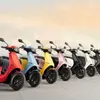Why Reliance-backed startup Altigreen pivoted to manufacture electric three-wheelers
Founded in 2013, Altigreen pivoted to manufacture electric three-wheelers in 2018. The startup is backed by the likes of Sixth Sense Ventures, Reliance New Energy, and more.
In February, raised $39.8 million from Sixth Sense Ventures, along with Reliance New Energy, Xponentia Capital, Accurant International, US, and Momentum Venture Capital, Singapore.
The startup has also been announcing several strategic partnerships. In January 2022, Altigreen partnered with Delhi-based EV charging solutions startup Massive Mobility to install 25,000 on-demand charging stations in the next two years to be set up in towns and cities across the country.
Earlier, in December 2021, Altigreen bagged orders from , an electric vehicles platform, for over 1,500 commercial electric vehicles worth Rs 75 crore, with MoEVing’s charging hubs to be the authorised service centre.
For Altigreen, this was validation of their transition from an e-mobility technologies venture to a manufacturer of electric three-wheelers. This pivot, which began in 2018, saw the startup develop nearly 200 electric three-wheelers last year, eliciting interest from customers like Mahindra Logistics.
A year ago, Altigreen had a target of having close to 1,000 electric three-wheelers on the road.
“These are our internal milestones because it creates a certain sense of maturity within the organisation, and shows that our supply chain has worked out,” Amitabh Saran, Founder and CEO, Altigreen tells YourStory.
From drivetrain to EV developer
Altigreen, founded in 2013, started off as a technology enabler for electric vehicles. It wanted to create the electric drivetrain for hybrid or fully electric vehicles.
In 2018, Amitabh decided that Altigreen would develop electric vehicles, adding that the market wasn’t aggressive with respect to electric mobility up until then.
“Everyone has a certain DNA, and that DNA is fossil-fuel oriented. It's not very simple for them to change,” Amitabh notes.
The transition was slow, he says as customers clearly found it difficult to move from the established internal combustion engine (ICE).
“We evaluated our (realistic) capabilities to deliver a product that could compete in both price and performance against the fossil fuel counterpart,” added Amitabh.
For three-wheelers, there are two major tailwinds — the rapid growth of ecommerce putting pressure on logistics to find rugged yet affordable delivery solutions, and rapidly increasing urban mobility using metro trains, which is leading to a rise in the need for last-mile transportation (passenger).
According to the Society of Indian Automobile Manufacturers (SIAM), OEMs sold more than one lakh three-wheelers with ICEs each year until the outbreak of the pandemic in March 2020.
Domestic sales of ICE three-wheelers fell to 82,110 units in fiscal year (FY) 2021, added SIAM. In the first half of FY 2022, the sales were at 32,198 units. This indicates a solid addressable market for an e-mobility player.
Altigreen showcased its first vehicle at Auto Expo 2018, and began sales in January 2021.

Why last-mile segment
Altigreen has sold close to 200 electric three-wheelers to the last mile segment. It partnered with Mahindra Logistics in mid-2021.
The startup opted for this segment as last-mile mobility would be the first to adopt EVs – two-wheelers, three-wheelers, and small-commercial four-wheelers. It focuses on the B2B segment.
“The organised B2B market is a segment that adopts first, and they are okay to take a few risks,” Amitabh says.
At the time of the recent funding, Nikhil Vora, Founder and CEO of Sixth Sense, said, “We draw comfort with Altigreen’s primary focus on the three-wheeler segment within the EV space, which fundamentally is less cluttered and under-penetrated, as well as benefits multiple stakeholders in the value chain (from ecommerce players to consumers).”
This segment has a market share of about 15 percent while the unorganised individual owners comprise the remaining 85 percent of the 1.2 million three-wheelers in India, according to Amitabh’s estimates.
Last-mile segments in sectors like ecommerce have the potential to switch to electric mobility faster than in B2C segments of three-wheelers.
Amitabh shared that the real growth and establishment would happen when they cater to the 85 percent market share. But the company decided to be launch in the organised B2B segment as there is a lesser cost in marketing and Altigreen claims it has close to zero marketing cost.
This year, the startup will address both passenger and cargo in B2B and B2C segments in 2022.

Convincing investors
Shifting the focus of a company does not come easy. Investors needed to be told why Altigreen is pivoting, especially to an asset-heavy business.
However, Amitabh says while it can be difficult to convince those who invested at an earlier stage, it is also important to identify the right kind of investors. This is what worked for the startup.
Altigreen has focused on staying nimble and adapting to changes, and retained its purpose — ’to be carbon free’.
Alitgreen has 26 technology patents covering innovations in Motors, Components within Motors, Control Algorithms, Strategies to improve efficiency, and functions provided in its vehicles. Each of these is used in its EV components, as well as vehicles.
So far, the startup has been able to provide a tested range of about 150-180 kilometres on a single charge and over 120 kmph on the roads. The charging can be done using a normal 220-volt 16-amp switch socket with a downtime of about 4 hours.
Altigreen made a revenue of Rs 103.82 lakhs in FY 2020-21, Rs 61.62 lakhs for FY 2019-20 and Rs 193.53 for FY 2018-19, according to Reliance Industries exchange filings.
The startup sources its materials from suppliers within the country except for electronics and microprocessors. Its batteries are manufactured in India, with only the Lithium-Ferrous-Phosphate (LFP) cells being imported as they are still not fabricated in India.
Altigreen has the approval to sell in 14 states with service centres, and has operations in 12 cities including Delhi-NCR, Kolkata, Hyderabad, Chennai, Bengaluru, Mumbai, Pune, Coimbatore, and Ahmedabad. It plans to launch in Surat and Jaipur soon.
The startup is also ramping up its manufacturing capabilities from the current 6,000 per annum to 36,000 per annum in the next few months. At present, it develops its vehicles only in the Bengaluru facility.

Future of electric three-wheelers and competition
With soaring fossil fuel prices, electric three-wheelers have come out as the winner with their overall lower Total Cost of Ownership (TCO). As the adoption of EVs is on the rise, the market sees many existing players entering the field.
Some of the companies that manufacture electric three-wheelers include Kinetic Green Energy and Power Solutions, Piaggio India, and Mahindra Electric.
This demand is also validated by an increasing number of state governments bringing EV-friendly policies.
“While fleet aggregators have been the early adopters, we do find increasing traction among individual captive buyers given the phenomenal economics in favour of an electric three-wheeler versus fossil fuels,” says Suman Mishra, CEO of Mahindra Electric.
While businesses are pushing for electrification, analysts who look at this sector have a different opinion.
According to them, EV adoption can be slightly inferior to Compressed Natural Gas (CNG). Especially in the short commercial or the individual fleet, CNG is much easier for adoption and gains the upper hand as the risk perception is higher for them and technology only adds to this.
Other challenges remain like wider adoption, the need for more financers in the segment, and public charging infrastructure across the country.
Extended warranties and resale values at the end of an ownership cycle can help facilitate adoption, something that manufacturers will have to consider, as well as the role of the sales and service network.
Is our future electric? The OEMs certainly think so.
Only time will tell.
Edited by Saheli Sen Gupta



![[Funding alert] EV startup Altigreen raises $39.8M in Series A round](https://images.yourstory.com/cs/2/40d66ae0f37111eb854989d40ab39087/ImagesFrames22-1644556641142.png?fm=png&auto=format&h=100&w=100&crop=entropy&fit=crop)






